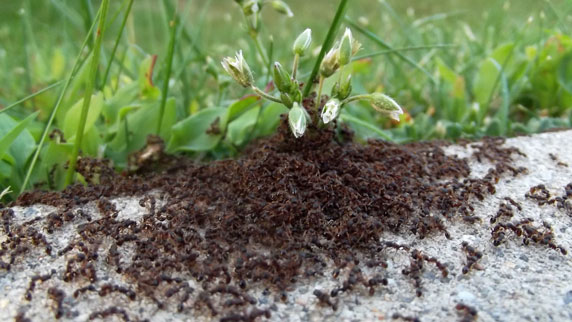Winter Clean Up Starts Inside When Pavement Ants Awaken In Southern New Hampshire
By Chris Williams on March 4, 2015.

When pavement ants (Tetramorium caespitum) come out of hibernation, it is every ant on deck. Large numbers of these small 3-4 mm, usually dark ants can emerge inside structures, even in the coldest months. Most sightings occur on floors, and lower areas of the structure. Heated basements, radiant heating under slabs, open crawl spaces, increased temperatures near fireplaces, woodstoves, heating systems can provide the warmth needed to stimulate their activities.
Pavement ants are excellent janitors and will not leave a scrap on the floor. Once abundant food sources are located, foraging ants range out in search of new discoveries. Foraging areas may extend into other areas of the structure such as counter tops, stovetops, dirty microwave ovens, spills in cabinets, walls, and even beds as worker ants investigate the area.
Pavement ants can be active throughout the year depending on the location of the nest. Pavement ant nests can be located almost anywhere there is some soil. Like all ants, nests vary in size according to age, location, and resources available. These ants are the ones that are usually responsible for making the little piles of sand along driveways, in patios, and along masonry edges. pavement ant swarming, or reproduction, takes place several times a year. Billions+? of male and female pavement ants fly up and away from established colonies in a mating frenzy. Most die, un-mated, and end up as food for many animals, or are recycled through decay.
Where I live in Rye, NH (Jenness Beach) is covered in these ants twice a year, all dead or dying at the high tide lines. Once this massive event takes place, billions of queen pavement ants have been fertilized by the tiny male pavement ants (1/3 the size of the queen). Once mating takes place, the queens cut their wings off with their sharp mandibles. Fertilized queen Pavement ants need to find a place to hide and fast. Once an acceptable location is located, she will dig an initial chamber to lay the first eggs. Once hatched, the tiny larvae will be fed by the queen.
Within a few weeks the first adult ants, all female, will have hatched and begun the duties of caring for the eggs, larvae, pupae, and foraging for food to feed the young pavement ant colony. Food sources naturally include sweet and greasy substances: fruit, chips, soda, sugar, syrup, bacon, pet food, baby formula, honey, meat, fat, dead insects, and dead animals, to name a few–you get it. Adult ants seek out food sources creating a pheromone trail back to any discoveries. Other ants quickly arrive at the new feeding site, even if the food is gone; the pheromone trail is still there recruiting other workers to that area. All food items are promptly brought to the developing larvae.
Pavement ant larvae are the stomach of the ant colony. Larvae digest food material and secrete a nutritious fluid that the adults rely on for survival. As the larvae develop, they pupate in small cocoons. Pupae become adult ants, now able to work for the colony or become reproductives that will benefit the species as a whole and leave the colony. The queen pavement ant uses her pheromones to control the makeup of the ant colony. When the colony is mature, most of its energy goes into producing reproductives for swarming. To produce reproductives, many workers must forage as soon as possible. This accounts for the fast increase of activity once a pavement ant colony wakes up.
Control of pavement ants in New Hampshire, Southern Maine, and Eastern Massachusetts is not that hard. At Colonial Pest Control, we take advantage of the natural foraging behavior of pavement ants. In most cases, least toxic bait placements are made in cracks and crevices, wall voids, and under carpet edges where the pavement ant workers will encounter and take the bait. In some cases, interior treatments are used to augment the action of the bait and limit foraging activities within the active living space. Once treatment has taken place, there may be activity for several days as the colony picks up the bait and feeds the larvae. Recently hatched adults may emerge and attempt to forage but cannot survive without the colony.
When pavement ants strike, call the professionals at Colonial Pest Control!
Photo credit: Fractality / Foter / CC BY